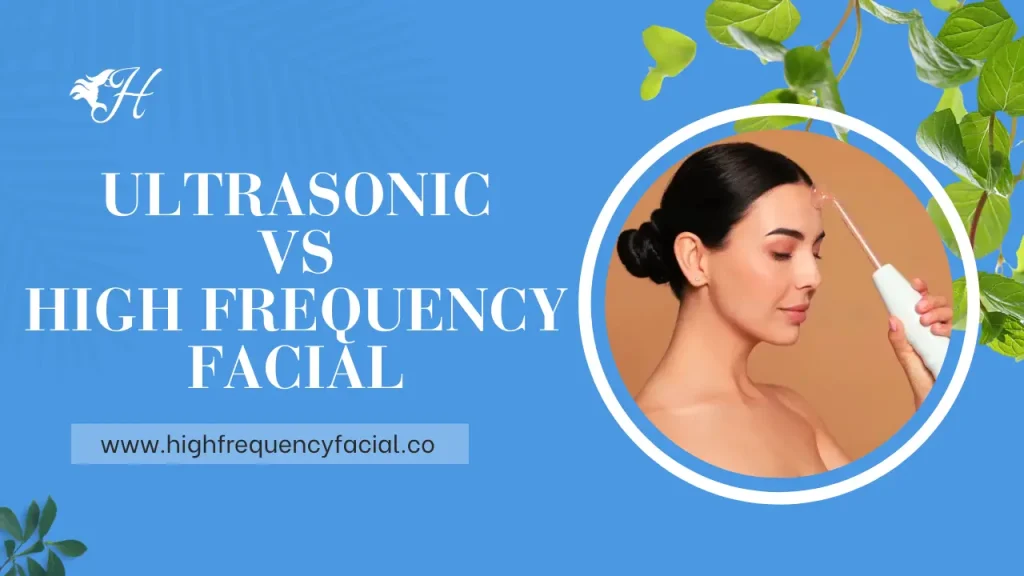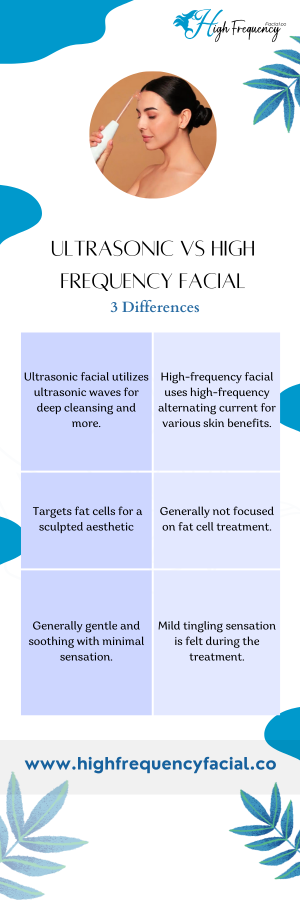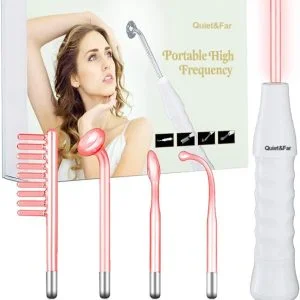Today, we’re about to compare two popular facial treatments: the ultrasonic vs the high-frequency facial.
We’ll explore what sets each apart, how they work, and the specific skin concerns they address. Whether you’re aiming for a deep clean, wrinkle reduction, or acne prevention, we’ll break down the differences to help you choose the facial that aligns with your skincare goals.
Let’s dive in!


Ultrasonic Facial:
The ultrasonic facial is an advanced skincare treatment that uses high-frequency sound waves.
Using a handheld device, these waves deeply clean the skin, giving it a refreshed appearance. The generated effect stimulates the skin to increase collagen production, reducing lines and wrinkles for a smoother complexion.
As the ultrasound enters the body, it triggers reactions that improve oxygen supply, aid in waste removal, and have an antibacterial effect, helping prevent acne. Operating at frequencies like 1 MHz or 3 MHz, these rapid vibrations provide comprehensive skincare benefits, with noticeable results even after a single session.
This non-invasive procedure, recommended by skincare experts, goes beyond surface benefits and effectively targets fat cells for a sculpted aesthetic.
Benefits of Ultrasonic Facial:
- Boosts Blood Circulation
- Facilitates Lymphatic Drainage
- Gently Removes Dead Skin Cells
- Elevates Cell Metabolism
- Purges Toxins Effectively
- Maximizes Skin Care Product Effectiveness
- Firms and Tones Neck, Body, and Facial Skin
- Diminishes Wrinkles and Fine Lines
- Minimizes Congested, Puffy Eyes
- Refines Enlarged Pores
- Enhances Skin Texture and Tone
- Clears Acne and Blemishes
- Brightens Dark Under-Eye Circles
- Reduces Cellulite and Fat Deposits
- Evens out Scars, Freckles, Age Spots, and Redness
High Frequency Facial:
The high-frequency facial involves using a handheld device that emits a gentle electrical current through a glass electrode onto the skin. This current produces a high-frequency oscillation, creating a thermal effect that boosts blood circulation and oxygenates the skin. The heat stimulates collagen production, improving skin elasticity.
Additionally, the treatment has an antibacterial effect, reducing acne and promoting clearer skin. The process enhances the absorption of skincare products and decongests the skin by opening pores.
Benefits of high frequency facial:
- Acne and Blemishes
- Fine Lines and Wrinkles
- Puffiness Around the Eyes
- Dull or Uneven Skin Texture
- Enlarged Pores
- Poor Blood Circulation
- Sagging Skin
- Dark Under-Eye Circles
- Dry or Dehydrated Skin
- Overall Skin Rejuvenation
Ultrasonic Vs High-Frequency Facial:
Here are several differences between ultrasonic and high-frequency facial to help you choose one:
| Aspect | Ultrasonic Facial | High-Frequency Facial |
|---|---|---|
| Technology Used | Utilizes ultrasonic waves for deep cleansing and more. | Employs high-frequency alternating current for various skin benefits. |
| Primary Purpose | Deep cleansing, exfoliation, and collagen stimulation. | Targets acne, promotes collagen, and enhances overall skin health. |
| Mechanism | Emits sound waves for deep penetration and exfoliation. | Applies electrical current to stimulate skin and improve various concerns. |
| Targeted Issues | Skin texture, wrinkles, and deep tissue regeneration. | Acne, collagen production, blood circulation, and skin rejuvenation. |
| Penetration Depth | Penetrates into deeper skin layers for collagen boost. | Focuses on surface and subdermal layers for various skin benefits. |
| Collagen Stimulation | Stimulates collagen production for skin rejuvenation. | Aids in collagen production, contributing to skin firmness and elasticity. |
| Product Absorption | Enhances absorption of skincare products for efficacy. | Maximizes product penetration, ensuring better results from skincare. |
| Treatment Feel | Generally gentle and soothing with minimal sensation. | Produces a mild tingling sensation due to electrical current. |
| Frequency Range | Typically 20,000 to 30,000 hertz. | Utilizes high-frequency alternating current, typically in the kHz range. |
| Fat Cell Treatment | Some devices contribute to fat cell destruction. | Generally not focused on fat cell treatment. |
| Immediate Effects | Leaves skin feeling fresh, softer, and revitalized. | Instantly firms the skin and reduce puffiness. |
| Recommended Usage | Can be part of a regular skincare routine. | Often used as a targeted treatment for specific issues. |


Potential Side Effects of Ultrasonic Facial:
Potential side effects of ultrasonic facial treatment include:
- Redness lasting more than a day after treatment.
- Skin feeling tender for over a month after the session.
- Swelling that sticks around for more than four weeks, even with a cold compress.
- Bleeding under the skin that doesn’t go away within two weeks.
Additionally, some people might experience:
- A bit of bruising.
- Slight redness.
- Temporary lip and/or brow paralysis.
It’s important to remember that, although the treatment is generally safe, it may not be suitable for individuals who are pregnant, breastfeeding, or have conditions like lupus or rheumatoid arthritis.
Potential Side Effects of High Frequency Facial:
Potential side effects of high-frequency facial treatment include:
- Some individuals experience redness on the treated areas, which is usually temporary but persists for a short duration.
- Due to the electrical current used in high-frequency facials, a mild tingling sensation is felt during the treatment.
- In certain cases, individuals encounter minimal bruising, particularly if the skin is sensitive or reactive.
- Slight skin irritation, such as itchiness or discomfort, occurs, but it typically resolves shortly after the treatment.
- In some cases, the skin becomes temporarily dry or experiences mild peeling post-treatment.
However, individuals with specific medical conditions or those who are pregnant should consult with a skincare professional before undergoing this treatment. Always make sure that the aftercare for high frequency facial is done right for optimal results.
Which is Better Ultrasonic or High Frequency Facial?
The choice between an ultrasonic and high-frequency facial depends on individual skincare needs.
An ultrasonic facial is ideal for those seeking deep cleansing, exfoliation, and collagen stimulation, resulting in improved skin texture and reduced fine lines.
On the other hand, a high-frequency facial focuses on treating acne, stimulating collagen production, and enhancing blood circulation, leading to improved skin tone and enhanced product absorption.
Ultimately, the decision should be based on specific skincare goals and concerns. Consulting with a skincare professional will help determine which treatment aligns better with individual needs, ensuring a personalized approach to achieve optimal results.
Conclusion:
In the face-off between ultrasonic and high-frequency facials, the winner depends on what you’re looking for. Want deep cleaning, collagen boost, and a sculpted look? Ultrasonic is your go-to. Need to tackle acne, enhance collagen, and improve overall skin health? High frequency has got your back. The decision boils down to your specific skincare goals.
So, whether you’re leaning towards the soothing sound waves of ultrasonic or the tingling sensation of high frequency, each has its strengths. Consulting with a skincare expert ensures you make the right choice for your unique skin requirements, making the path to healthier, glowing skin a personalized journey.






